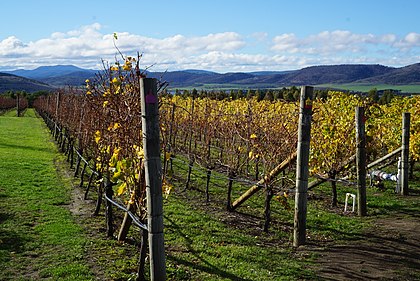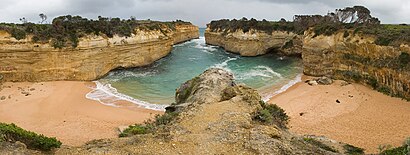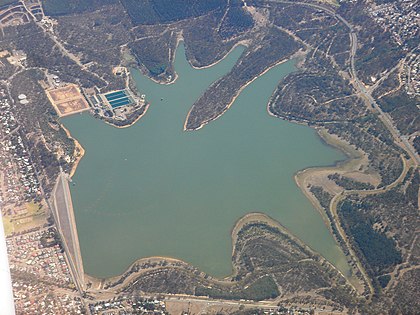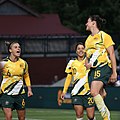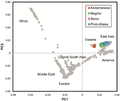| Showcase | Content | Interesting facts | Contributing |
Introduction

Australia, officially the Commonwealth of Australia, is a country comprising the mainland of the Australian continent, the island of Tasmania and numerous smaller islands. Australia has a total area of 7,688,287 km2 (2,968,464 sq mi), making it the sixth-largest country in the world and the largest in Oceania. It is the world's oldest, flattest, and driest inhabited continent, with some of the least fertile soils. It is a megadiverse country, and its size gives it a wide variety of landscapes and climates including deserts in the interior and tropical rainforests along the coast.
The ancestors of Aboriginal Australians began arriving from south-east Asia 50,000 to 65,000 years ago, during the last glacial period. By the time of British settlement, Aboriginal Australians spoke 250 distinct languages and had the oldest living culture in the world. Australia's written history commenced with Dutch exploration of most of the coastline in the 17th-century. British colonisation began in 1788 with the establishment of the penal colony of New South Wales. By the mid-19th century, most of the continent had been explored by European settlers and five additional self-governing British colonies were established, each gaining responsible government by 1890. The colonies federated in 1901, forming the Commonwealth of Australia. This continued a process of increasing autonomy from the United Kingdom, highlighted by the Statute of Westminster Adoption Act 1942, and culminating in the Australia Acts of 1986.
Australia is a federal parliamentary democracy and constitutional monarchy comprising six states and ten territories. Its population of more than 28 million is highly urbanised and heavily concentrated on the eastern seaboard. Canberra is the nation's capital, while its most populous cities are Sydney and Melbourne, both with a population of more than 5 million. Australia's culture is diverse, and the country has one of the highest foreign-born populations in the world. It has a highly developed economy and one of the highest per capita incomes globally. Its abundant natural resources and well-developed international trade relations are crucial to the country's economy. It ranks highly for quality of life, health, education, economic freedom, civil liberties and political rights.
Featured article -
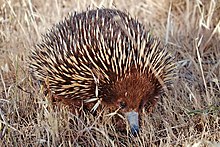
The short-beaked echidna (Tachyglossus aculeatus), also called the short-nosed echidna, is one of four living species of echidna, and the only member of the genus Tachyglossus. It is covered in fur and spines and has a distinctive snout and a specialised tongue, which it uses to catch its insect prey at a great speed. Like the other extant monotremes, the short-beaked echidna lays eggs; the monotremes are the only living group of mammals to do so. (Full article...)
Selected biography -

Lieutenant General Sir James Whiteside McCay, KCMG, KBE, CB, VD (21 December 1864 – 1 October 1930), who often spelt his surname M'Cay, was an Australian general and politician. (Full article...)
Did you know (auto-generated) -
- ... that Ged Kearney represented Batman in the Parliament of Australia from 2018 to 2019?
- ... that starting at age 16, future Woolworths CEO Brad Banducci was named top sewing machine salesperson three years in a row?
- ... that Turkish international soccer player Rojin Polat was named member of the "2021 All Schools Merit Girls Team" in New South Wales, Australia?
- ... that pumices erupted by the Protector Shoal volcano in 1962 floated to Australia and South America?
- ... that Australia-born rugby union player Jason Jones-Hughes was the subject of a protracted legal battle over his international eligibility after Wales called him up for the 1999 Rugby World Cup?
- ... that Australian official Jack Emanuel was awarded the George Cross in 1971 after being stabbed to death whilst trying to resolve a land dispute with the Tolai people of New Guinea?
- ... that in 2010, Lauren Mitchell became the first Australian female artistic gymnast to win a world title?
- ... that the dominant species in the Iron-grass Natural Temperate Grassland of South Australia are often not grasses at all?
In the news
- 20 December 2024 – Australia–Solomon Islands relations
- Australia agrees to provide Solomon Islands with financing, training, and infrastructure support worth AU$190 million (US$118 million) over four years to strengthen its police force as part of a renewed security partnership between the two countries. (France 24)
- 16 December 2024 – 2024 Australia heat wave
- Walpeup, Victoria, Australia, reports a temperature of 47.1 °C (116.8 °F), the hottest temperature reported in the state since 2019. Extreme heat wave warnings and fire risk warnings are also issued for areas across Australia. (The Guardian) (ABC News Australia)
- 15 December 2024 – Australia–Indonesia relations
- Australian Prime Minister Anthony Albanese announces that the remaining five members of the Bali Nine drug-trafficking group, who were serving life sentences in Indonesia, have returned to Australia following an agreement between the two countries to end their imprisonment. (CNN)
- 9 December 2024 – Australia–Nauru relations
- Australia and Nauru announce a joint security treaty that will see Australia sending Nauru AU$100 million (US$64 million) in direct support over five years in exchange for Nauru consulting Australia before signing any bilateral agreements with other countries. (DW) (Nikkei Asia)
- 6 December 2024 – Antisemitism in Australia
- Two people are injured in an arson attack on a synagogue in Melbourne, Australia. (DW) (The Australian Jewish News)
- 2 December 2024 – Maritime drug smuggling into Australia
- Australian Federal Police announces they have arrested thirteen men, including the vice president of the outlaw Comanchero Motorcycle Club and two teenagers, for illegally smuggling 2.34 tonnes of cocaine into the country after their fishing boat broke down off the coast of Urangan, Queensland, Australia. (Al Jazeera) (RNZ) (ABC News)
Selected pictures -
On this day

- 1817 – The King expedition of 1817, to explore and make a rough survey of the northern and north-west coasts of Australia, departs Sydney.
- 1911 – The Commonwealth Bank of Australia is established.
- 1919 – Susan Grace Benny becomes the first Australian woman elected to a local government.
- 1989 – Two tourist coaches collide on the Pacific Highway north of Kempsey, New South Wales, 35 killed and 39 injured.
General images
Topics
More portals
WikiProject
 |
 |
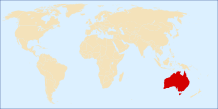
| |
Consider joining WikiProject Australia, a WikiProject dedicated to improving Wikipedia's coverage of topics related to Australia. The project page and its subpages contain suggestions on formatting and style of articles, which can be discussed at the project's notice board. To participate, simply add your name to the project members page.
As of 22 December 2024, there are 206,180 articles within the scope of WikiProject Australia, of which 595 are featured and 886 are good articles. This makes up 2.98% of the articles on Wikipedia, 5.33% of all featured articles and lists, and 2.18% of all good articles (see WP:AUSFG). Including non-article pages, such as talk pages, redirects, categories, etc., there are 454,868 pages in the project.
Associated Wikimedia
The following Wikimedia Foundation sister projects provide more on this subject:
-
Commons
Free media repository -
Wikibooks
Free textbooks and manuals -
Wikidata
Free knowledge base -
Wikinews
Free-content news -
Wikiquote
Collection of quotations -
Wikisource
Free-content library -
Wikiversity
Free learning tools -
Wikivoyage
Free travel guide -
Wiktionary
Dictionary and thesaurus







